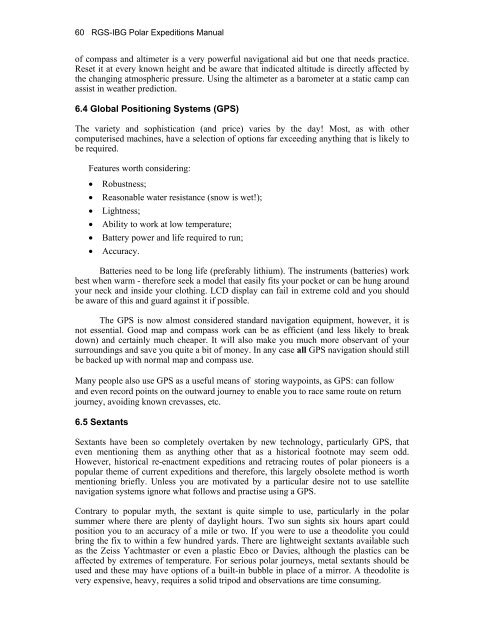Edited by Rachel Duncan 4th Edition ISBN 0-907649-91-2 London ...
Edited by Rachel Duncan 4th Edition ISBN 0-907649-91-2 London ...
Edited by Rachel Duncan 4th Edition ISBN 0-907649-91-2 London ...
Create successful ePaper yourself
Turn your PDF publications into a flip-book with our unique Google optimized e-Paper software.
60 RGS-IBG Polar Expeditions Manual<br />
of compass and altimeter is a very powerful navigational aid but one that needs practice.<br />
Reset it at every known height and be aware that indicated altitude is directly affected <strong>by</strong><br />
the changing atmospheric pressure. Using the altimeter as a barometer at a static camp can<br />
assist in weather prediction.<br />
6.4 Global Positioning Systems (GPS)<br />
The variety and sophistication (and price) varies <strong>by</strong> the day! Most, as with other<br />
computerised machines, have a selection of options far exceeding anything that is likely to<br />
be required.<br />
Features worth considering:<br />
• Robustness;<br />
• Reasonable water resistance (snow is wet!);<br />
• Lightness;<br />
• Ability to work at low temperature;<br />
• Battery power and life required to run;<br />
• Accuracy.<br />
Batteries need to be long life (preferably lithium). The instruments (batteries) work<br />
best when warm - therefore seek a model that easily fits your pocket or can be hung around<br />
your neck and inside your clothing. LCD display can fail in extreme cold and you should<br />
be aware of this and guard against it if possible.<br />
The GPS is now almost considered standard navigation equipment, however, it is<br />
not essential. Good map and compass work can be as efficient (and less likely to break<br />
down) and certainly much cheaper. It will also make you much more observant of your<br />
surroundings and save you quite a bit of money. In any case all GPS navigation should still<br />
be backed up with normal map and compass use.<br />
Many people also use GPS as a useful means of storing waypoints, as GPS: can follow<br />
and even record points on the outward journey to enable you to race same route on return<br />
journey, avoiding known crevasses, etc.<br />
6.5 Sextants<br />
Sextants have been so completely overtaken <strong>by</strong> new technology, particularly GPS, that<br />
even mentioning them as anything other that as a historical footnote may seem odd.<br />
However, historical re-enactment expeditions and retracing routes of polar pioneers is a<br />
popular theme of current expeditions and therefore, this largely obsolete method is worth<br />
mentioning briefly. Unless you are motivated <strong>by</strong> a particular desire not to use satellite<br />
navigation systems ignore what follows and practise using a GPS.<br />
Contrary to popular myth, the sextant is quite simple to use, particularly in the polar<br />
summer where there are plenty of daylight hours. Two sun sights six hours apart could<br />
position you to an accuracy of a mile or two. If you were to use a theodolite you could<br />
bring the fix to within a few hundred yards. There are lightweight sextants available such<br />
as the Zeiss Yachtmaster or even a plastic Ebco or Davies, although the plastics can be<br />
affected <strong>by</strong> extremes of temperature. For serious polar journeys, metal sextants should be<br />
used and these may have options of a built-in bubble in place of a mirror. A theodolite is<br />
very expensive, heavy, requires a solid tripod and observations are time consuming.

















